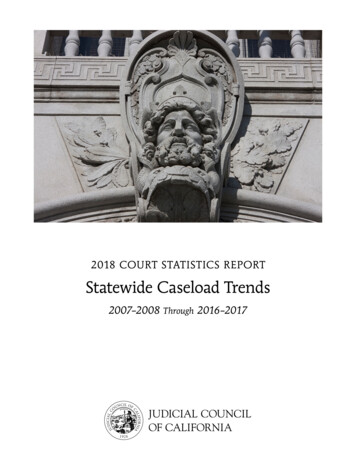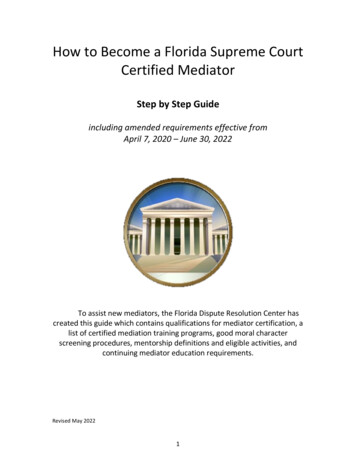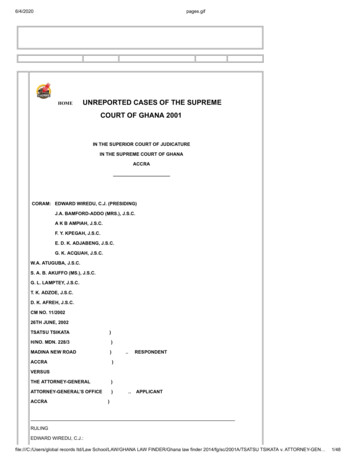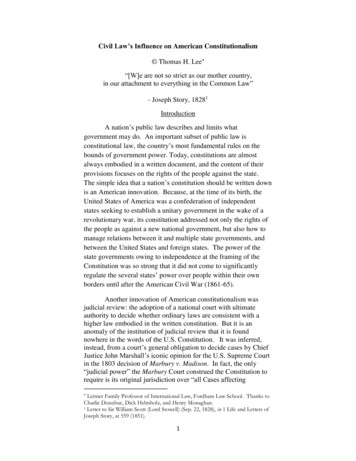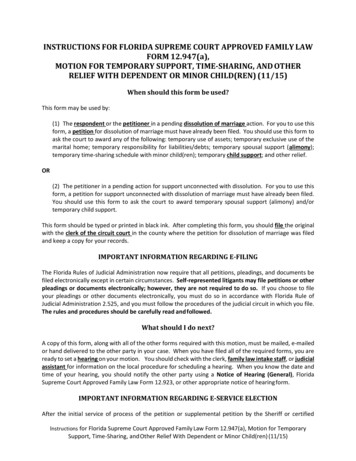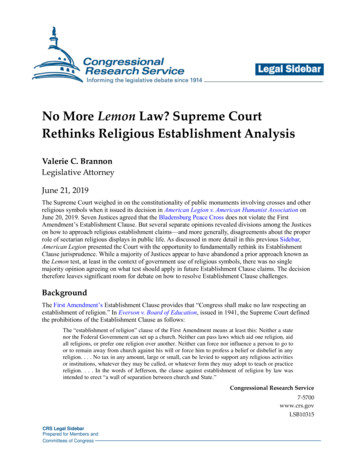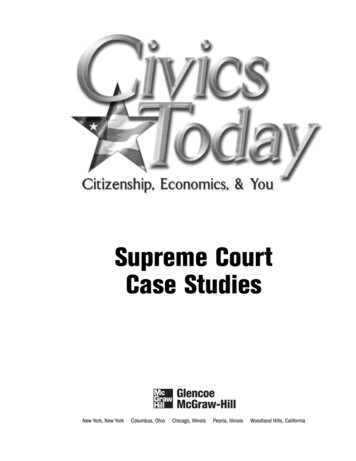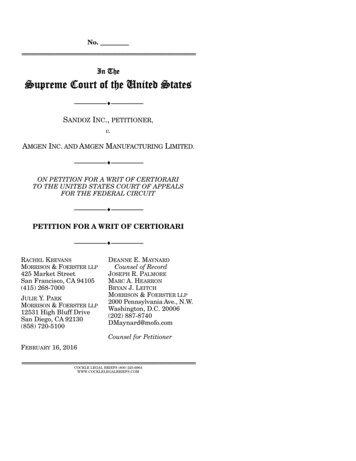
Transcription
No. In TheSupreme Court of the United States--------------------------------- ---------------------------------SANDOZ INC., PETITIONER,v.AMGEN INC. AND AMGEN MANUFACTURING LIMITED.--------------------------------- --------------------------------ON PETITION FOR A WRIT OF CERTIORARITO THE UNITED STATES COURT OF APPEALSFOR THE FEDERAL CIRCUIT--------------------------------- ---------------------------------PETITION FOR A WRIT OF CERTIORARI--------------------------------- --------------------------------RACHEL KREVANSMORRISON & FOERSTER LLP425 Market StreetSan Francisco, CA 94105(415) 268-7000JULIE Y. PARKMORRISON & FOERSTER LLP12531 High Bluff DriveSan Diego, CA 92130(858) 720-5100DEANNE E. MAYNARDCounsel of RecordJOSEPH R. PALMOREMARC A. HEARRONBRYAN J. LEITCHMORRISON & FOERSTER LLP2000 Pennsylvania Ave., N.W.Washington, D.C. 20006(202) 887-8740DMaynard@mofo.comCounsel for PetitionerFEBRUARY 16, 2016 COCKLE LEGAL BRIEFS (800) 225-6964WWW.COCKLELEGALBRIEFS.COM
QUESTIONS PRESENTEDIn the Biologics Price Competition and Innovation Act of 2009 (“BPCIA”), Congress created anabbreviated regulatory pathway for the Food andDrug Administration (“FDA”) to license “biosimilar”products—i.e., products that are “highly similar” toapproved biological products. 42 U.S.C. § 262(i)(2).The BPCIA’s “Notice of commercial marketing” provision states that a biosimilar applicant shall providenotice to the incumbent seller of the biological product “not later than 180 days before the date of thefirst commercial marketing of the biological productlicensed under” this abbreviated pathway.Id.§ 262(l)(8)(A) (emphasis added).The Federal Circuit concluded that a biosimilarapplicant “may only give effective notice of commercial marketing after the FDA has licensed its product.” App., infra, 20a (emphasis added). As thedissenting judge recognized, the Federal Circuitturned this mere notice provision into a grant of 180days of additional exclusivity for all biological products beyond the exclusivity period Congress expresslyprovided—delaying the launch of all futurebiosimilars by six months. The Federal Circuittransformed the notice provision into a stand-alonerequirement unconnected to the patent resolutionprovisions of the BPCIA. It also disregarded the onlyremedy provided by Congress—the right to initiate
iiQUESTIONS PRESENTED—Continuedpatent litigation—and instead created its own extrastatutory injunctive remedy to bar the launch ofFDA-approved biosimilars.The questions presented are:Whether notice of commercial marketing givenbefore FDA approval can be effective and whether, inany event, treating Section 262(l)(8)(A) as a standalone requirement and creating an injunctive remedythat delays all biosimilars by 180 days after approvalis improper.
iiiPARTIES TO THE PROCEEDING AND RULE29.6 CORPORATE DISCLOSURE STATEMENTThe parties to the proceeding are listed in the1caption.Pursuant to Rule 29.6, petitioner Sandoz Inc.states the following:Sandoz Inc. is an indirect, wholly owned subsidiary of Novartis AG, which trades on the SIX SwissExchange under the ticker symbol NOVN and whoseAmerican Depository Shares are publicly traded onthe New York Stock Exchange under the ticker symbol NVS.1Amgen Inc. and Amgen Manufacturing Limited are bothrespondents in this Court. This petition refers to those entitiescollectively as “Amgen.”
ivTABLE OF CONTENTSPageQUESTIONS PRESENTED .iPARTIES TO THE PROCEEDING AND RULE29.6 CORPORATE DISCLOSURE STATEMENT .iiiTABLE OF AUTHORITIES . viiOPINIONS BELOW.1JURISDICTION .1STATUTORY PROVISIONS INVOLVED .1INTRODUCTION .2STATEMENT .8A.Statutory Background .8B.Factual Background . 121. Sandoz’s biosimilar application. 122. Proceedings in district court . 133. Proceedings in the Federal Circuit . 16REASONS FOR GRANTING THE PETITION . 22THEFEDERALCIRCUIT’S“EXTRASTATUTORY EXCLUSIVITY WINDFALL” ISCONTRARY TO THE STATUTE’S TEXTAND PURPOSE AS WELL AS THISCOURT’S PRECEDENTS . 22A.The Federal Circuit’s Post-ApprovalLimitation Is Contrary To The Text AndPurpose Of The Notice Of CommercialMarketing Provision And Conflicts WithThis Court’s Decisions . 23
vTABLE OF CONTENTS—ContinuedPage1. The Federal Circuit’s interpretationof Section 262(l)(8)(A) conflicts withthe statutory text and upends theprovision’s purpose . 232. The Federal Circuit’s ruling disruptsthe careful balance struck by Congress by delaying the launch of everybiosimilar product by six months . 273. The Federal Circuit erroneouslydivorced the notice of commercialmarketing provision from the patentresolution scheme and created anextra-textual injunctive remedy toenforce it . 31B.This Court’s Review Is Urgently NeededBecause The Federal Circuit’s Ruling IsDelaying The Availability Of AllBiosimilars And Will Continue To Do SoUntil This Court Corrects The Circuit’sInterpretation . 37CONCLUSION. 42APPENDIX A: Opinion of the U.S. Court ofAppeals for the Federal Circuit .1aAPPENDIX B: Opinion of the U.S. DistrictCourt for the Northern District of California .56aAPPENDIX C: Order of the U.S. Court ofAppeals for the Federal Circuit Denying Petitions for Rehearing En Banc .85a
viTABLE OF CONTENTS—ContinuedPageAPPENDIX D: Biologics Price Competition andInnovation Act of 2009 (“BPCIA”), Pub. L.No. 111-148, §§ 7001-7003, 124 Stat. 119,804-21 (2010) .87aAPPENDIX E: Excerpts of Titles 28, 35, and 42of the U.S. Code.127a
viiTABLE OF AUTHORITIESPageCASESAlexander v. Sandoval, 532 U.S. 275 (2001) . 31, 32, 35Amgen Inc. v. Apotex Inc., No. 15-61631 (S.D.Fla. Dec. 9, 2015), appeal docketed, No. 161308 (Fed. Cir. Dec. 11, 2015) .35, 41Amgen Inc. v. Hospira, Inc., No. 15-839 (D. Del.Nov. 6, 2015) .41Colorado v. Idarado Mining Co., 916 F.2d 1486(10th Cir. 1990) .32eBay Inc. v. MercExchange, L.L.C., 547 U.S.388 (2006) .34, 36Eli Lilly & Co. v. Medtronic, Inc., 496 U.S. 661(1990) .9FEC v. Wis. Right to Life, Inc., 551 U.S. 449(2007) .36, 37Glaxo, Inc. v. Novopharm, Ltd., 110 F.3d 1562(Fed. Cir. 1997) .27Janssen Biotech, Inc. v. Celltrion HealthcareCo., No. 15-10698 (D. Mass. Aug. 24, 2015) .41Karahalios v. Nat’l Fed’n of Fed. Emps., 489U.S. 527 (1989) .32, 36MedImmune, Inc. v. Genentech, Inc., 549 U.S.118 (2007) .27Sandoz Inc. v. Amgen Inc., 773 F.3d 1274 (Fed.Cir. 2014) .26Touche Ross & Co. v. Redington, 442 U.S. 560(1979) .33
viiiTABLE OF AUTHORITIES—ContinuedPageUnited States v. EME Homer City Generation,L.P., 727 F.3d 274 (3d Cir. 2013) .32Wheeling-Pittsburgh Steel Corp. v. Mitsui &Co., 221 F.3d 924 (6th Cir. 2000) .32Whitman v. Am. Trucking Ass’ns, Inc., 531 U.S.457 (2001) .25STATUTES AND RULES28 U.S.C. § 1254(1) .128 U.S.C. § 2201(b) .935 U.S.C. § 271(a) .2735 U.S.C. § 271(e)(2)(C) . 7, 9, 10, 30, 33, 3435 U.S.C. § 271(e)(2)(C)(ii) . 10, 11, 3535 U.S.C. § 271(e)(4) . 9, 10, 20, 33, 3435 U.S.C. § 271(e)(4)(D) .935 U.S.C. § 271(e)(6) . 9, 10, 33, 3435 U.S.C. § 271(g) .2742 U.S.C. § 262(a)(1)(A) .2442 U.S.C. § 262(i)(1).242 U.S.C. § 262(i)(2).2, 4, 2742 U.S.C. § 262(i)(4).2442 U.S.C. § 262(k) .4, 8, 2742 U.S.C. § 262(k)-(m) .942 U.S.C. § 262(k)(7)(A). 4, 9, 12, 15, 28, 29
ixTABLE OF AUTHORITIES—ContinuedPage42 U.S.C. § 262(l)(1)(H) .3342 U.S.C. § 262(l)(2)-(9) .942 U.S.C. § 262(l)(2)(A) . 10, 16, 18, 2642 U.S.C. § 262(l)(3)-(5) .1042 U.S.C. § 262(l)(6) .10, 3342 U.S.C. § 262(l)(8)(A) . 1, 5, 6, 10, 11, 17, 22, 23. 24, 25, 26, 3442 U.S.C. § 262(l)(8)(B) . 11, 23, 3042 U.S.C. § 262(l)(9)(A) . 10, 30, 3342 U.S.C. § 262(l)(9)(B) . 7, 10, 11, 18, 33, 34, 3542 U.S.C. § 262(l)(9)(C) . 10, 11, 13, 14, 1642 U.S.C. § 262(m)(2)(A).2842 U.S.C. § 262(m)(3) .25Biologics Price Competition and Innovation Actof 2009, Pub. L. No. 111-148, 124 Stat. 119(2010):§§ 7001-7003.9§ 7001(b) .8, 27Cal. Bus. & Prof. Code § 17200 et seq. .13Sup. Ct. R. 10(c) .22Fed. R. Civ. P. 54(b) .15
xTABLE OF AUTHORITIES—ContinuedPageOTHER AUTHORITIESAgriculture, Rural Development, Food andDrug Administration, and Related AgenciesAppropriations for Fiscal Year 2014, Hearings Before a Subcomm. of the Comm. onAppropriations on H.R. 2410/S. 1244, 113thCong. (2013) (statements of Dr. Margaret A.Hamburg) .39Andrew W. Mulcahy, Zachary Predmore &Soeren Mattke, RAND Corp., The Cost Savings Potential of Biosimilar Drugs in theUnited States (2014) .40CBO, Pub. No. 4043, Effects of Using GenericDrugs on Medicare’s Drug Spending (Sept.2010) .38, 39CBO Cost Estimate, S.1695: Biologics PriceCompetition and Innovation Act of 2007(June 25, 2008) .4, 39CRS, John R. Thomas, Follow-On Biologics:The Law and Intellectual Property Issues(2014) .40Draft Guidance, FDA, Guidance for Industry:Reference Product Exclusivity for BiologicalProducts Filed Under Section 351(a) of thePHS Act (Aug. 2014) .29FDA, Biosimilar Biological Product Authorization Performance Goals and Procedures Fiscal Years 2013 Through 2017 .12
xiTABLE OF AUTHORITIES—ContinuedPageFDA, What are “Biologics” Questions andAnswers (last visited Feb. 12, 2016) .2FTC, Emerging Health Care Issues: Follow-onBiologic Drug Competition (June 2009) .3, 40FTC, Public Workshop: Follow-On Biologics:Impact of Recent Legislative and RegulatoryNaming Proposals on Competition, 78 Fed.Reg. 68,840 (Nov. 15, 2013).38Judith A. Johnson, Cong. Research Serv.,RL34045, FDA Regulation of Follow-On Biologics (2009) .3Letter from CBO Dir. Douglas W. Elmendorf toHon. Nancy Pelosi, Speaker U.S. House ofRep. (Mar. 20, 2010) .4, 40Press Release, FDA, FDA Approves FirstBiosimilar Product Zarxio (Mar. 6, 2015) .26Robert J. Shapiro, et al., The Potential American Market for Generic Biological Treatmentsand the Associated Cost Savings (Feb. 2008) .38Sandoz: Several Biosimilars in Late-StageClinical Trials .37Testimony of James Cosgrove, Director, HealthCare, GAO, before the House Subcommitteeon Health, Committee on Energy and Commerce (June 28, 2013) .41
PETITION FOR A WRIT OF CERTIORARIPetitioner Sandoz Inc. respectfully petitions for awrit of certiorari to review the judgment of the United States Court of Appeals for the Federal Circuit.OPINIONS BELOWThe opinion of the court of appeals (App., infra,1a-55a) is reported at 794 F.3d 1347. The opinion ofthe district court (App., infra, 56a-84a) is unreportedbut is available at 2015 WL 1264756.JURISDICTIONThe court of appeals entered judgment on July21, 2015. Timely rehearing petitions were denied onOctober 16, 2015. App., infra, 85a-86a. On December29, 2015, the Chief Justice extended the time forSandoz to petition for a writ of certiorari to andincluding February 16, 2016. This Court’s jurisdiction is invoked under 28 U.S.C. § 1254(1).STATUTORY PROVISIONS INVOLVEDThe BPCIA, Pub. L. No. 111-148, §§ 7001-7003,124 Stat. 119, 804-21 (2010), and the relevant provisions of Titles 28, 35, and 42 of the United StatesCode amended by the BPCIA are reprinted in theappendix. App., infra, 87a-163a. Section 262(l)(8)(A)of Title 42 provides:(A)Notice of commercial marketingThe subsection (k) applicant shall providenotice to the reference product sponsor notlater than 180 days before the date of thefirst commercial marketing of the biologicalproduct licensed under subsection (k).
2INTRODUCTIONCongress enacted the BPCIA as part of thePatient Protection and Affordable Care Act to createcompetition in the biologic pharmaceuticals marketand to reduce prices. Biologics are used to treatnumerous medical conditions. See 42 U.S.C. § 262(i)(1).In contrast to chemically synthesized drugs, biologics“are isolated from a variety of natural sources—human, animal, or microorganism.” FDA, What are“Biologics” Questions and Answers.1 Biologics “oftenrepresent the cutting-edge of biomedical research and,in time, may offer the most effective means to treat avariety of medical illnesses and conditions thatpresently have no other treatments available.” Ibid.Biosimilars are “highly similar” to approvedbiological products, which the BPCIA refers to as“reference product[s].” 42 U.S.C. § 262(i)(2). Thedevelopment of a biosimilar version of a biologic isgenerally much more expensive and time-consumingthan the development of a generic version of a chemically synthesized drug. A Federal Trade Commission(“FTC”) report estimates that biosimilars are “likelyto take eight to ten years to develop, and their development will likely cost between 100 and 200 million”—in contrast to the three to five years and 1 to 5 million it typically costs to develop a htm (last visited Feb. 12,2016).
3version of a chemically synthesized drug. FTC,Emerging Health Care Issues: Follow-on BiologicDrug Competition iii (June 2009) (“FTC Report”).2When Congress passed the BPCIA, purchases ofbiologics represented 21% of the 307 billion spentannually on medicines, and spending on biologics wasincreasing materially. CA JA A389-A391. The recordbefore Congress showed that more competition in thebiologics market could save government and privatepayors tens of billions of dollars. E.g., Judith A.Johnson, Cong. Research Serv., RL34045, FDA Regulation of Follow-On Biologics 4 (2010).3 Before theBPCIA’s enactment, the FTC predicted that biosimilarswould enter the market “at price discounts between10 and 30 percent” off the reference product’s price,and that the incumbent seller of the biological product—called the “reference product sponsor” in theBPCIA—would “respond aggressively and offercompetitive discounts.” FTC Report, supra, at 23.The Congressional Budget Office (“CBO”) estimatedthat the introduction of biosimilars “would reducetotal expenditures on biologics in the United States* * * by about 25 billion over the 2009-2018 maryimmune.org/advocacy center/pdfs/healthcare reform/Biosimilars Congressional Research Service Report.pdf.
4CBO Cost Estimate, S. 1695: Biologics Price Competition and Innovation Act of 2007 1 (June 25, 2008).4The CBO projected that savings for the federal government alone would be 7 billion from 2010 to 2019.Letter from CBO Dir. Douglas W. Elmendorf to Hon.Nancy Pelosi, Speaker U.S. House of Rep., Table 5 at10 (Mar. 20, 2010).5To provide more direct competition, the BPCIAcreated an abbreviated regulatory pathway for FDAapproval of biosimilars, allowing a biosimilar applicant to rely in part on the previous approval of thesponsor’s reference product. App., infra, 4a-5a; 42 U.S.C.§ 262(i)(2), (k). At the same time and in order “[t]obalance innovation and price competition,” Congressprovided sponsors up to twelve years of marketexclusivity against follow-on biosimilar products—regardless of whether the sponsor has any validpatent claims covering the biosimilar. App., infra, 5a6a; see 42 U.S.C. § 262(k)(7)(A).Congress also provided for early resolution ofpatent disputes, by creating new artificial infringement actions that can be brought before FDA approval of a biosimilar and before any actual infringementoccurs. Congress did not, however, link FDA approvalof biosimilars to the pendency or outcome of ostestimate/amendreconprop.pdf.
5patent suit. Rather, the FDA can license a biosimilarimmediately upon expiration of the statutorily determined exclusivity period for the reference product.For a product sponsor to enjoin the marketing of acompeting biosimilar, it must bring a patent infringement suit and make the requisite showing for apatent-based injunction.In a fragmented decision, the Federal Circuit hasdisrupted the careful balance struck by Congressbetween competition and innovation. If not reversed,the Federal Circuit’s ruling will delay access bypatients to all biosimilars for six months longer thanCongress intended. The Federal Circuit reached thatresult by adding an extra-textual limitation to theBPCIA’s “Notice of commercial marketing” provision.That provision calls for “notice to the reference product sponsor not later than 180 days before the date ofthe first commercial marketing of the biological product licensed under subsection (k),” i.e., the abbreviated biosimilar pathway.42 U.S.C. § 262(l)(8)(A)(emphasis added). The Federal Circuit held that anapplicant “may only give effective notice of commercial marketing after the FDA has licensed its product.” App., infra, 20a (emphasis added).A majority of the Federal Circuit panel thenenforced that erroneous reading by divorcing thatprovision from the BPCIA’s patent resolution regimeand replacing the remedies expressly provided in theBPCIA with a new remedy: “a 180-day injunctionbeyond the express twelve-year statutory exclusivityperiod.” App., infra, 43a-44a (Chen, J., dissenting).
6As Judge Chen recognized in dissent, the majorityeffectively awarded sponsors “an extra-statutoryexclusivity windfall” of 180 days more than Congressexpressly granted. App., infra, 44a (Chen, J., dissenting).The Federal Circuit’s decision cannot besquared with the BPCIA’s text and purpose, and itconflicts with this Court’s precedents. As the districtcourt observed, if Congress had wanted to add sixmonths to the statutory exclusivity period, “it couldnot have chosen a more convoluted method of doingso.” App., infra, 76a.By its plain terms, the notice of commercialmarketing provision simply calls for 180 days’ noticebefore a biosimilar is marketed. Regardless of whether notice is given before or after FDA approval of thebiosimilar, the notice would serve the statute’s purpose of giving the reference product sponsor at least180 days to initiate suit. But special notice after FDAapproval would be superfluous, as FDA licensure is apublic act. The Federal Circuit reached its erroneousconclusion by reading too much into the word “licensed” in subsection (l)(8)(A). That adjective merelyrefers to the biosimilar product that will be marketed,which will be licensed by the time of marketing.Nothing in the text provides that an applicant mustwait until the FDA publicly approves its biosimilar,then provide “notice” of its self-evident intent tomarket that approved biosimilar, and then wait sixmonths more before marketing its product.The Federal Circuit compounded this error bydisconnecting Section 262(l)(8)(A) from the BPCIA’s
7patent resolution regime and by creating a newremedy nowhere provided by the BPCIA: an injunction against commercial marketing until 180 daysafter post-approval notice is given. If Congress hadso intended, it knew how to stay FDA approval for180 days; it also knew how to authorize injunctions toenforce the notice provision. It did neither. Instead,it provided sponsors with a powerful remedy: a patentsuit for artificial infringement that could be broughteven before FDA approval. 42 U.S.C. § 262(l)(9)(B),(C); 35 U.S.C. § 271(e)(2)(C). Although Amgen broughtsuch a suit, it made no attempt (and still has not) toseek an injunction based on any alleged patent infringement by Sandoz.Without any such patent showing by Amgen, theplain terms of the BPCIA authorized Sandoz to makeits biosimilar filgrastim product Zarxio immediatelyavailable to cancer patients upon FDA approval:(1) Sandoz already had provided Amgen more than180 days’ notice of its intent to market, giving Amgentime to bring suit (which it did) and seek a patentbased injunction (which it did not), and (2) any statutory exclusivity period had expired, as Amgen alreadyhad enjoyed 24 years of exclusivity. See App., infra,8a-9a. Instead, due to the Federal Circuit’s erroneousinterpretation of the notice of commercial marketingprovision, competition was excluded from the marketwell beyond the exclusivity period granted by Congress, and cancer patients had to wait many monthsafter FDA approval of Sandoz’s product for access tomore affordable medicine.
8This issue is critically important. As one of theseveral amici supporting Sandoz’s en banc petitionexplained, “the provision at issue here is a key element of a key statute governing an industry at thevanguard of health care delivery in the 21st Centu6ry.” Absent intervention from this Court, the FederalCircuit’s ruling in this case will apply nationwide todelay the availability of every FDA-approvedbiosimilar for six months longer than Congress intended. Given the importance of this issue to patients, payors (including the federal government), andpharmaceutical companies, that delay should not beallowed to persist without this Court’s review.STATEMENTA. Statutory BackgroundCongress struck a careful balance in the BPCIAbetween facilitating prompt access to cost-savingbiosimilars and promoting innovation in biologicalproducts. BPCIA § 7001(b), 124 Stat. at 804 (reproduced at App., infra, 87a-126a). The statute allowsan applicant to rely in part on the sponsor’s licensefor the approved reference product in order to speedbiosimilar market entry. 42 U.S.C. § 262(k). Inexchange, the BPCIA gives biologics sponsors a totalof 12 years without biosimilar competition: the FDAcannot “ma[k]e effective” approval of a biosimilar“until the date that is 12 years after the date on6at 4.Hospira, Inc., et al. Amici Curiae Br., CAFC Dkt. No. 140,
9which the reference product was first licensed” by theFDA. Id. § 262(k)(7)(A).The BPCIA also facilitates early resolution ofpotential patent disputes in order to speed biologicsto market. To this end, the BPCIA made interlockingamendments to Titles 28, 35, and 42 of the UnitedStates Code. Pub. L. No. 111-148, 124 Stat. 804(codified at 28 U.S.C. § 2201(b); 35 U.S.C. § 271(e)(2)(C),(4)(D), (6); 42 U.S.C. § 262(k)-(m)) (reproduced atApp., infra, 127a-163a). In particular, the BPCIAamended the Patent Act to make submission of abiosimilar application to the FDA an artificial act ofinfringement under certain circumstances. 35 U.S.C.§ 271(e)(2)(C). That provision allows a declaratoryjudgment action on patent infringement and validitybefore any actual infringement is imminent. Cf. EliLilly & Co. v. Medtronic, Inc., 496 U.S. 661, 678(1990) (discussing Congress’s creation of an “artificialact of infringement” in order to “enable the judicialadjudication” of patent claims). Who can bring suchan action, when, and for what relief depends on theactions or inactions at each step of a multi-stepinformation exchange process between the applicantand the sponsor regarding the sponsor’s possiblepatent claims. 35 U.S.C. § 271(e)(2)(C), (4), (6); 28U.S.C. § 2201(b); 42 U.S.C. § 262(l)(2)-(9).Congress spelled out the actions the applicant orsponsor “shall” take to start and continue the process.Under the first step of the exchange process, theapplicant provides a copy of its biosimilar applicationto the sponsor within 20 days after the FDA accepts
10the application for review. 42 U.S.C. § 262(l)(2)(A).In later steps, the parties exchange lists of patents forwhich they believe a claim of patent infringementcould reasonably be asserted; exchange their respective positions on infringement, validity, and enforceability; and negotiate regarding the patents for whichan immediate infringement action may be brought.Id. § 262(l)(3)-(5).Congress also spelled out exactly what happens ifa party declines to follow a particular step in theinformation exchange process. For example, if theapplicant does not take the first step (i.e., provide itsbiosimilar application to the sponsor within 20 daysof its acceptance by the FDA), the BPCIA expresslylays out a separate path for resolving any patentdisputes: patent infringement litigation, with thescope and timing at the sole discretion of the reference product sponsor. Id. § 262(l)(9)(C); 35 U.S.C.§ 271(e)(2)(C)(ii). And even if the patent exchangeprocess is initiated, and regardless of whether it iscompleted, the end result is that the reference product sponsor or the applicant can bring suit for patentinfringement. The contours of that suit are determined by the actions that the parties did or did nottake in the information exchange process. 35 U.S.C.§ 271(e)(2)(C), (4), (6); 42 U.S.C. § 262(l)(6), (9)(A)-(B).As particularly relevant to this petition, theBPCIA includes a provision entitled “Notice of commercial marketing.” 42 U.S.C. § 262(l)(8)(A). Thatprovision states:
11The subsection (k) applicant [i.e., thebiosimilar applicant] shall provide notice tothe reference product sponsor not later than180 days before the date of the first commercial marketing of the biological product licensed under subsection (k) [i.e., thebiosimilar product].Ibid. This provision provides notice to the sponsorthat a biosimilar is at least six months from comingto market and allows the sponsor to seek a preliminary injunction to enforce any patent claims it hasnot yet been able to enforce in the exchange process.Id. § 262(l)(8)(A)-(B).Critically, the BPCIA also expressly specifies aconsequence for not providing the notice of commercial marketing. Where the applicant has initiated thepatent exchange process and the sponsor has provided its initial list of possibly relevant patents to theapplicant, the consequence of the applicant’s notproviding the notice is that “the reference productsponsor, but not the [biosimilar] applicant, may bringan action” for a declaration of infringement, validity,or enforceability of any patent on that list. Id.§ 262(l)(9)(B). And where the applicant did notinitiate the patent exchange process by providing itsbiosimilar application, that non-provision of theapplication already had triggered the sponsor’sability to bring an action for a declaration of infringement of any patent.See 35 U.S.C.§ 271(e)(2)(C)(ii); 42 U.S.C. § 262(l)(9)(C).
12B. Factual Background1. Sandoz’s biosimilar applicationWhen Sandoz applied for FDA approval of itsfilgrastim biosimilar, Amgen already had marketedfilgrastim under the brand name Neupogen for 24years—twice the 12-year period Congress deemedsufficient to encourage innovation in biologics. App.,infra, 8a; 42 U.S.C. § 262(k)(7)(A).On July 7, 2014, the FDA accepted for reviewSandoz’s application for biosimilar filgrastim. App.,infra, 8a. The next day, Sando
Answers (last visited Feb. 12, 2016) . 2 FTC, Emerging Health Care Issues: Follow-on Biologic Drug Competition (June 2009) . 3, 40 FTC, Public Workshop: Follow-On Biologics: Impact of Recent Legislative and Regulatory Naming Proposals on Competition, 78 Fed.


